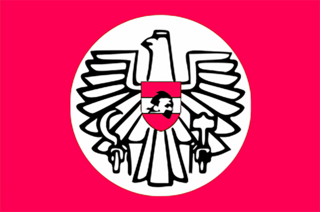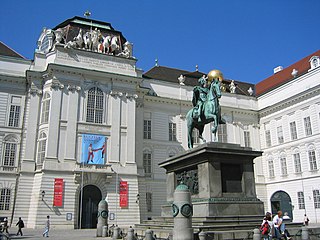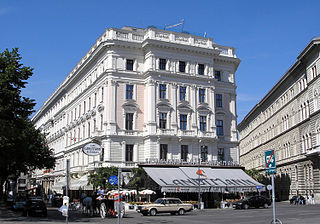
Kugelmugel, officially the People's Republic of Kugelmugel, is a micronation located in Vienna, Austria. It resulted from a dispute between the artist Edwin Lipburger and the Austrian authorities, due to his permission to build a spherical house. Today it's administered by Mag. Linda Treiber.

The Imperial Crown of Austria is a crown formerly in use by the monarchs of the Habsburg monarchy. The crown was originally made in 1602 in Prague by Jan Vermeyen as the personal crown of Holy Roman Emperor Rudolf II, and therefore is also known as the Crown of Emperor Rudolf II. The crown was used as a private crown of the Holy Roman Emperors and Kings of Hungary and Bohemia from the House of Habsburg. In 1804 it became the official crown of the newly constituted Austrian Empire. After 1867 it remained the imperial crown of the Cisleithanian part of the Austro-Hungarian Empire until 1918.

St. Rupert's Church is a Romanesque church in Vienna, Austria. Traditionally considered to be the oldest church in the city, St. Rupert's Church is dedicated to Saint Rupert of Salzburg, patron saint of the salt merchants of Vienna. The church is located in one of the oldest parts of the city, the section of the Roman Vindobona.

Josefsplatz is a public square located at the Hofburg Palace in Vienna, Austria. Named after Emperor Joseph II, Josefsplatz is considered one of the finest courtyards in Vienna.

Maria-Theresien-Platz is a large public square in Vienna, Austria, that joins the Ringstraße with the Museumsquartier, a museum of modern arts located in the former Imperial Stables. Facing each other from the sides of the square are two near identical buildings, the Naturhistorisches Museum and the Kunsthistorisches Museum. The buildings are near identical, except for the statuary on their façades. The Naturhistorisches' façade has statues depicting personifications of Africa, Asia, Europe, and the Americas. The Kunsthistorisches façade features famous European artists, such as the Dutch Bruegel, among others.

Palais Augarten is a Baroque palace in the district of Leopoldstadt, Vienna, Austria. Constructed in the late seventeenth century by Johann Bernhard Fischer von Erlach on the site of a Jagdschloss and gardens, the palace and gardens were expanded in the nineteenth century under Emperor Franz Joseph I of Austria. Despite extensive damage suffered during World War II, the palace has been maintained almost in its original appearance, and many of the original furnishings can still be found there. Today, Palais Augarten is the home and rehearsal space of the Vienna Boys' Choir, who also have their own school there. The palace is located in the 130-acre Augarten park, which is the oldest Baroque garden in Vienna.

Palais Harrach is a Baroque-style palace located at Freyung 3 in Vienna, Austria. It was originally owned by the noble Harrach family. The building was extensively restored and renovated in the late 1990s, and it now houses offices and shops.
Resan is a 1987 documentary film by Peter Watkins, made between the years 1983 and 1985 on several continents, and structured around the theme of nuclear weapons, military spending and poverty. Ordinary people are asked about their awareness of these issues.

Penzing is the 14th borough of Vienna and consists of the localities of Penzing, Breitensee, Baumgarten, Hütteldorf and Hadersdorf-Weidlingau. In the west, it shares a border with Purkersdorf and Mauerbach. A large portion of the district is made up of greenery, including the Steinhof park, the Dehnepark and a portion of the Wienerwald.

The Church of the Teutonic Order, also known as the Church of Saint Elisabeth of Hungary, is the mother church of the Teutonic Order, a German-based Roman Catholic religious order formed at the end of the 12th century. Located in Vienna, Austria, near the Stephansdom, it is the current seat of the Grand Master of the Order.

The ruins of Falkenstein Castle is in the Weinviertel region of Lower Austria, about 55 kilometres (34 mi) north of Vienna near the border to Czech Republic.

Café Landtmann is a traditional Viennese café located on the Ringstraße at the corner of Lowelstraße 22 in the Innere Stadt first district in Vienna, Austria.

The Imperial Sword is one of the four most important parts of the Imperial Regalia (Reichskleinodien) of the Holy Roman Empire. During a coronation, it was given to the emperor along with the Imperial Crown (Reichskrone), Imperial Sceptre (Reichszepter), and the Imperial Orb (Reichsapfel). All four parts of the Imperial Regalia are displayed in the Imperial Treasury at the Hofburg Palace in Vienna, Austria. It is also known as Mauritiusschwert, or the sword of Saint Maurice.

The Agate Bowl is a hardstone carving in the shape of a bowl cut out of a single piece of agate, possibly in the fourth century at the court of Constantine, and now displayed in the Imperial Treasury at the Hofburg Palace in Vienna, Austria. For centuries it was widely regarded as the "greatest masterpiece" and the "best and most important piece" in the collection. In 1564, Holy Roman Emperor Maximillian II and his brothers declared it by deed to be an "inalienable heirloom of the house of Austria". They valued this ancient precious stone carving, not just for its craftsmanship, but for a "natural miracle" in the stone itself that reveals a mysterious inscription—the name XRISTO (Christ) at the bottom of the bowl within the grain of the stone. It is now generally believed that the inscription inspired the legend that the bowl was the Holy Grail. The Agate Bowl is the largest carved stone bowl in the world.

The Wienbibliothek im Rathaus, formerly known as the Wiener Stadt- und Landesbibliothek, is a library and archive containing important documents related to the history of Vienna, Austria. Founded in 1856, the library, which also contains a large collection of local memorabilia, is located in the Rathaus in the Innere Stadt first district of the city, and is the official library of the city and state of Vienna.

The Volksgarten is a public park in the Innere Stadt first district of Vienna, Austria. The garden, which is part of the Hofburg Palace, was laid out by Ludwig Remy in 1821. The park was built over the city fortifications that were destroyed by Napoleon in 1809. The Volksgarten was opened to the public in 1823.

Palais Porcia is a former urban residence in the western quarter of the Innere Stadt of Vienna, Austria. It stands at 23, Herrengasse between Palais Kinsky and Palais Trautmansdorff and across Palais Harrach. The palace was built in 1546 for the descendants of Count Gabriel von Salamanca-Ortenburg. It was representative of the simple Renaissance style that emerged in Vienna in the middle of the 16th century. In the 17th and later centuries it was extensively remodelled in Baroque and Rococo styles but the inner court still contains an early Renaissance arcade. As of 2010, Palais Porcia houses the Administrative Library of the Austrian Federal Chancellery.

The Imperial Treasury at the Hofburg Palace in Vienna, Austria contains a valuable collection of secular and ecclesiastical treasures covering over a thousand years of European history. The entrance to the treasury is at the Schweizerhof, the oldest part of the palace, which was rebuilt in the sixteenth century in the Renaissance style under Holy Roman Emperor Ferdinand I. The Imperial Treasury is affiliated with the Kunsthistorisches Museum, and houses in 21 rooms a collection of rare treasures that were compiled by the Imperial House of Habsburg over the course of centuries, including the Imperial Crown, Orb, and Sceptre of Austria, and the Imperial Regalia of the Emperors and Kings of the Holy Roman Empire, including the Imperial Crown of the Holy Roman Empire.

The Winter Palace of Prince Eugene, also known as the City Palace, is a high-Baroque palace in the Innere Stadt district of Vienna, Austria. Located on a narrow street at Himmelpfortgasse 8, the palace was used as the winter residence of Prince Eugene of Savoy, who spent his summers at the Belvedere. The Winter Palace was designed and constructed by Johann Bernhard Fischer von Erlach from 1695 to 1700, and by Johann Lukas von Hildebrandt from 1702 to 1724 following his predecessor's plans.


















